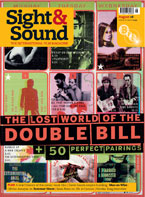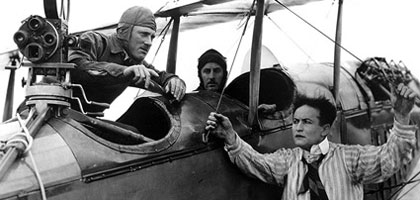
NOZONE: The Great Escape
DVD Review: Houdini The Movie Star

Dismissed as folly and very nearly destroyed, Houdini's films escaped oblivion - but only just, writes Tim Lucas
USA 1919-23; Kino on Video/Region 0; 450 minutes; Aspect Ratio 4:3; Features: filmed records of Houdini escapes, audio recording of Houdini speaking, NY Censor Board files excerpts, 'Slippery Jim' (1910 Pathé Frères short inspired by Houdini), image galleries, film notes by Bret Wood, more
This three-disc set collects in one place the surviving film work of renowned 'self-liberationist' Harry Houdini (born Ehrich Weiss), which amounts to four of the five modest productions he made as an actor, writer, producer and director, and just enough supplementary newsreel footage to sate idle curiosity.
Houdini was not your usual leading man material - short, woolly-haired, compactly built with an impressively large head and an intense, brow-knitted expression that almost never relaxed - yet he managed to overcome his odd appearance and mannerisms through sheer personal magnetism. You can't take your eyes off him. In five short years, he became one of America's earliest pulp-action stars, one of the film industry's first multi-hyphenates, and perhaps the first actor ever to be credited by a single name - long before Garbo or Karloff. Despite all this, by the time it was over, his film career was generally regarded as folly. Houdini was already two years retired from films, and bitter about it, when he died of a burst appendix in 1926 at the age of 52. Some years afterwards, a fire inspection at the house of magician Theodore Hardeen, Houdini's brother and a partner in his film company, uncovered the original nitrate materials of Houdini's entire screen career, and Hardeen wept as he was forced by fire officers to deposit everything on the kerb for the morning garbage collection.
Now largely forgotten, Houdini's films managed to escape the jaws of oblivion, but just barely. Only his first independent production, the interesting reincarnation romance The Man from Beyond (1922), remains generally intact. His debut serial The Master Mystery (1919, directed by Burton King and Harry Grossman) survives minus nearly four of its 15 chapters; his finest effort, the rousing jungle adventure Terror Island (1920, directed by James Cruze), is missing what may have been its two most important reels; and his first feature, 1919's The Grim Game, has been whittled by time down to a mere five-minute fragment. Fortunately, it preserves the film's most talked-about scene: two prop planes accidentally collided and crashed while filming a stunt scene in which Houdini's character was to leap from one plane to the other. The accident looks genuine enough but was filmed at such a distance there was no need for the star not to have been doubled. Adding to one's suspicion is an attendant publicity dare, with Houdini (who was inserted into the dangerous stuff, à la Roger Moore, with studio close-ups) offering $10,000 to anyone able to prove the accident never happened - thus slyly deflecting the whole question of his actual involvement in it. The gaps in each of the films are ably filled with intertitles.
As much as Houdini The Movie Star is a portrait of the artist, it also valuably demonstrates how the ideas in the French pulp serials of Louis Feuillade came to roost in the American model. To that end, the unsung auteur of this set is Arthur B. Reeve, co-writer of Houdini's best movie work (The Master Mystery, Terror Island). Reeve came to this collaboration as the respected author of a series of popular scientific detection novels featuring an 'American Sherlock Holmes' named Craig Kennedy, which were published as a 12-volume set in 1918. Houdini's characters in these two Reeve pictures are basically Kennedy with other names: in The Master Mystery he's an overqualified patent-office employee who just happens to dabble in scientific breakthroughs (such as the silent gas bullet that eventually saves the day), and in Terror Island he's a just-plain-folks inventor who builds a fabulous submarine to recover lost treasure so that the lives of local children might be made more comfortable.
Both films borrow freely not only from Reeve's own work, but from Feuillade's Fantômas (1913) and Judex (1916), with corrupt businessmen, adult foundlings overseen by secret benefactors, and colourful master criminals - the Master Mystery serial alone includes a robot driven by a human brain, the evil adventuress DeLuxe Dora, Long Fang (oriental monarch of the underworld) and 'the Strangler from Madagascar'.
Rounding out the set is Houdini's self-made swan song Haldane of the Secret Service (1923), a stodgy spy thriller that fails to thrill despite globe-hopping location photography, a proto-Doctor No villain and a briefly impressive scene involving our hero's escape from the paddle-wheel of an old mill.
The set includes lengthy and engrossing film notes by disc producer Bret Wood, who allows that "the quality of the film elements in this collection is beneath Kino International's usual standards."The picture quality is certainly uneven, even within individual titles, but it's never less than acceptable - not that a certain fire department left posterity much choice in the matter. The musical scores are equally hit-and-miss, though Clark Wilson's Terror Island and Jon C. Mirsalis' The Man from Beyond succeed in investing the films with an emotional range they might not otherwise have.
